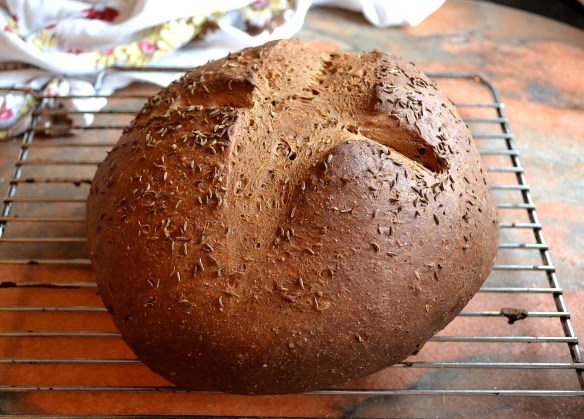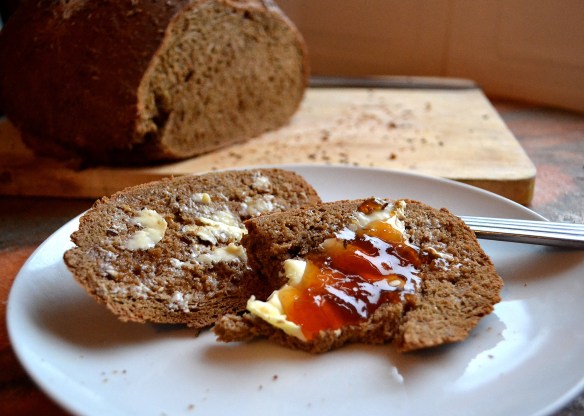 Bread-baking is the antidote to everything that people find frustrating about pastry. Measurements are imprecise and dependent on variables such as ambient humidity and elevation. You can be messy and aggressive; bread dough responds to abuse rather like a particularly eager masochist. Bread dough likes being slapped and pounded, and “rustic” is an aspirational term, rather than a euphemism.
Bread-baking is the antidote to everything that people find frustrating about pastry. Measurements are imprecise and dependent on variables such as ambient humidity and elevation. You can be messy and aggressive; bread dough responds to abuse rather like a particularly eager masochist. Bread dough likes being slapped and pounded, and “rustic” is an aspirational term, rather than a euphemism.
I first started baking bread when I was about 11. A snarky, competitive, and somewhat fatalistic child, I decided to become a bread baker because it was the only type of kitchen craft that my mother did not execute impeccably; I didn’t want to cook things that she would always do better. Mind you, I’m sure my mother would have baked gorgeous breads if she had been interested, but she was more inclined towards cakes and pastry. Like most childhood fixations, bread baking quickly became The Thing I Would Do When I Grew Up. (I think it fell in between nature photography and novelist.) My ever-tolerant parents indulged this obsession, as they had so many others. They bought me Bernard Clayton’s The Breads of France, which quickly became my bread-baking bible, and a recipe book from a quite lovely, still extant craft bakery in upstate New York – one of the first of its kind – called Bread Alone. They endured flour-spattered kitchens, leaden, tasteless, gray-crusted experiments, soggy bagels, and my persistent, unsuccessful efforts to create the perfect baguette.
Eventually and inevitably, I did learn how to bake bread. This loaf is one of my all-time favourites. It’s a bread that reminds me of New York: of the Lower East Side as it was when I was growing up, of Zabar’s, of Jewish delis. Russian black bread is made with a mix of rye and wheat flours. Some people also add bran; I do not. The black comes from thick blackstrap molasses, which also give the bread a nutty, earthy flavour. There’s the slightly bitter, aromatic bite of caraway and fennel. The characteristic roasting coffee beans smell comes from … coffee. The cocoa is non-traditional but a delicious addition. The result is a soft, delectable loaf, equally good with butter and jam or honey, or served alongside smoked fish or pickled herring. Butter is a customary ingredient, but you can substitute oil if you want a vegan bread. You can make this into one big “rustic” loaf like I did, bake it in two loaf tins, or form it into buns for dinner rolls. This bread would make very nice dinner rolls.
I adapted this recipe loosely from a black bread recipe written by the wonderful Sharyn Dimmick of the Kale Chronicles, supplementing it with the black bread of my memory. (Okay, I did look at some other black bread recipes too.) For me, this is exactly what black bread should taste like. I wouldn’t change a thing. Enjoy!  Ingredients:
Ingredients:
**Recipe measurements appear both in cups (US) and grams to accommodate readers from anywhere. If you’re confused about anything, please don’t hesitate to drop me a note and I’ll get back to you as soon as I can.
For the proofing:
1/3 cup (80 ml) warm water
2 and ¼ teaspoons active dry yeast
1 teaspoon sugar
For the bread:
Three tablespoons (50 g) butter, melted
1/3 cup (80 ml) black treacle or blackstrap molasses
¼ cup (60 ml) strong black coffee or 1 tablespoon espresso powder mixed with ¼ cup water
1 tablespoon unsweetened cocoa powder
2.5 teaspoons salt
1 tablespoon cider or malt vinegar
1 tablespoon caraway seeds
½ teaspoon fennel seeds, pulverized in a mortar and pestle
1 cup (240 ml) warm water
340 g (2 cups) rye flour
330 g (2 cups) bread flour, plus ½ additional cup
For the glaze
½ cup water
1 teaspoon potato starch or corn starch
1 teaspoon caraway seeds
Method:
In a small bowl, combine the sugar and 1/3 cup warm water, and sprinkle the yeast over the top. Set aside while you assemble your remaining ingredients. In another bowl, combine the butter, molasses, coffee, cocoa powder, salt, vinegar, and caraway and fennel seeds. After about 10 or 15 minutes, your yeast should have started bubbling and expanding. Add the yeast mixture to the wet ingredients and mix well.
Sprinkle in the rye flour and all but ½ cup of the bread flour. Add the additional cup of warm water and mix thoroughly. You can use an electric mixer and dough hook, but I prefer to use my hands. The dough mixture will be quite sticky. Sprinkle the remaining ½ cup of bread flour on a counter or large board, and turn your dough out of the bowl and start kneading it. Push it away from you with the heel of your hand and fold it back in on itself. Roll it from one hand to the other. Lift the lot and smack it down on the counter. Bread dough loves to be kneaded. After about five minutes of kneading, your dough should feel silky and supple. (In her terrific blog post, Sharyn said the dough should feel like your earlobe. That is actually a remarkably apt description.) Continue to knead for another few minutes, until you feel air pockets created by the excited yeast popping as you fold the dough.
Put the dough in a large buttered or oiled bowl, cover with a damp cloth, and leave in a warm place to rise for about an hour and a half, or until doubled in bulk. (If your home isn’t terribly warm, don’t fret. The dough will still rise; it just may take a little longer.) When the dough has doubled in bulk, punch it down and let it rise again for another 30 minutes.
Grease and lightly flour your desired baking receptacle(s). Form into loaves quite tightly, tucking the dough against itself like you’re wrapping a present with not quite enough wrapping paper. Place it seam side down, re-cover it with the damp cloth, and leave it to rise for another 45 minutes to an hour, or until it has again doubled in bulk.
While the bread is rising, preheat your oven to 350 degrees Fahrenheit (180 degrees Celsius). In a small saucepan, dissolve the starch in the water for the glaze, and heat to a boil. Brush the glaze over your risen bread, sprinkle with caraway seeds, and slash the surface with an X using a sharp knife or razor.
Bake, turning once, for about 40 minutes (less if you’re making smaller loaves or rolls), or until the bread is golden brown and the bottom has a nice hollow sound when you thump it. 
Cool on a wire rack, and try to resist devouring all at once.
Makes one large loaf, two small loaves, or multiple soft rolls. 

Great recipe…I will try it…
Wonderful! Please report back and let me know what you think. Thanks for visiting!
Susan
I am an awful pâtissière and a pretty okay boulangière! But I got the bread bug way later in my life. Good for you for having parents who indulged your bread-baking passion! I am a big fan of black bread. This loaf will definitely find a way into my kitchen this year!
I hope it does. I hope I find my way into your kitchen with it. 😉
Yes! That would be amazing! Let me know the next time you are in town!
Very nice-looking loaf of bread, Susan. Thanks for the shout-out.
Thank you for the wonderful inspiration and your lovely writing! I’m looking forward to trying your Swedish rye bread recipe soon!
This look lovely! Im gonna make a vegan version of this as my new years resolution is to get back to making my own bread.
I’m sure it will be delicious! I don’t think the butter makes a difference to the flavor. Let me know how it turns out, and come again soon!
Susan
That’s a handsome looking loaf of bread! I likes me some rye, both bread and whiskey! Speaking of Jewish delis, my mind runs more towards pastrami when I see a nice rye like that.
Happy New Year, Gene! I like pastrami on a nice chewy semi-sourdough rye. (Sourdough starter is bubbling away!) Heck, who am I kidding? I like pastrami, full stop. 😀
“A snarky, competitive, and somewhat fatalistic child”—I think you may have just described y 11 year old self. I am going to have to get our resident bread baker on this one.
From one precocious little sh*t to another, I salute you! Do get your resident bread baker on this; I’m eating it RIGHT NOW toasted with butter and honey and it is filling me with joy.
Pingback: Russian Black Bread | Susan eats London | bread | Scoop.it
I love making bread but have really only used white and whole meal flour. I bought some rye flour recently and love caraway. This has to be my first rye foray. GG
Cool! Let me know what you think. I love working with rye flour.
Pingback: In the belly of the beans | Gourmandistan
Great recipe, Susan. I love a sandwich made with good black bread or just eating a slice with a little butter.
I’m not receiving notification of your posts and just unsubscribed and re-subscribed to see if that will do anything. It couldn’t hurt. 🙂
Great — I hope it works. I have a real weakness for black bread. Just the smell of caraway is enough to make me crave it …
This sounds absolutely amazing. I love the idea of all those gorgeous ingredients going into one loaf and the colours are lovely.
Thank you so much — I’m delighted that the queen of baking and breads likes my bread! I do love the soft brown molasses color, especially since the bread itself is quite unexpectedly silky. 🙂
Susan, your bread looks fantastic! I will definitely try this recipe sometime soon. Thank you for sharing!
Thank you! You’re very welcome! If you do try it, please let me know what you think. 🙂
Any idea how many rolls this will make? I have been searching for a Black bread roll recipe for ages since I tried them in a restaurant in the Lake district unfortunately the next time we went back the chef had left and no-one had the process.
I’m guessing about a dozen? Let me know if you try it!
Will it significantly change anything if I don’t add the coffee? I’m not a huge fan…If the moisture from the coffee is necessary, could I add more water or molasses or something instead?
Hi Carol, my apologies. I just now saw this question. I’m sure I’m too late. I do think that the coffee adds an indefinable but particular aroma to the bread, without much altering the flavor, but if you’re not a fan, leave it out and see how you like it. Yes, do add that additional amount of liquid, but not by adding molasses, as molasses has a very strong taste and may overpower some of the more subtle elements.